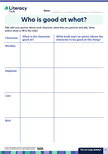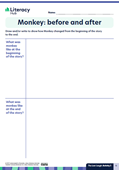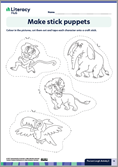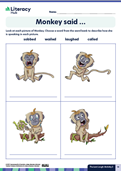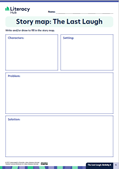The Last Laugh
This narrative is about boastful Monkey who loves swinging through the trees and singing as she twists and twirls. Monkey laughs at her friends who can’t do what she can! But one day Monkey realises just how special and clever her friends really are.
Back to the shared reading overview page
Text download
The Last Laugh as PDF (1.6MB) (opens in new window)
The Last Laugh as PowerPoint slideshow (36.7MB) (download)
Printable worksheets
|
|
|
|
|
| Who is good at what? (78KB) | Monkey: before and after (77KB) | Make stick puppets (681KB) | |
|
|
|

Teaching & learning sequence
This teaching and learning sequence outlines classroom strategies for The Last Laugh, including:
- ways to incorporate the ‘Big Six’ core elements of reading development
- fun, engaging and adaptable student activities for a diverse range of abilities
- links to the Australian Curriculum.
| Text features | Cross-curriculum links to the Australian Curriculum |
|
|

First read
As a whole group, enjoy sharing the text and learning together.
Engage
Ask students to think about all the things they are good at. What things do you like to do? What things are you good at? Have students turn to a partner and talk about this. In a whole-class discussion, encourage students to share their skills and talents such as cooking, drawing, singing, writing, running, telling jokes, or being a good friend. Draw the conclusion that different people are good at different things.
Show the front cover of The Last Laugh. Introduce the main character of the story, Monkey. What things might Monkey be good at? Discuss as a group.
Read aloud
Read the book aloud with few interruptions. Model reading with fluency and use expression. The aim is to engage students in the story, to entertain them and allow them to enjoy the plot, the illustrations and the language of the text.
After reading, engage the class in an open-ended discussion. What do you like about this book? What did you learn by hearing this story?
Reread the text. This time encourage students to join in as you read, particularly as the refrain is read on pages 3, 7, 11, 15 and 29. During this second read, stop and pose more specific questions to initiate discussion around the plot, the characters and their motivations. Why is Monkey laughing? What does this tell you about Monkey’s personality? What is Monkey feeling now? How can you tell? What did Monkey learn about her friends? What did she learn about herself?
Make meaning
Provide time for students to reflect on the story by participating in a class discussion. Prompt the students to think deeply about their responses by posing open-ended questions. What is your opinion of the story, and why? Who do you think is the most interesting character, and why? Do you think the author has a message? What might it be?
Have several strips of paper ready to scribe students’ responses onto as you reflect on the plot. Discuss as a whole group: What happened first in the story? What was the first main event? Write students’ ideas onto one of the strips of paper. Then what happened? What was the next main event? Again, use students’ responses to write down the second main event, onto another strip of paper. Continue until the whole story has been summarised, using a different strip of paper for each event.
Have students sit in a large circle, and use the statements on the strips of paper to retell the story. Read out each statement and invite students to place them into the correct order.
Revisit the text
Return to the text several times to look more closely at different aspects of its content, structure and language features. This is a great vehicle for exploring the ‘Big Six’ of literacy in an integrated way, with all components linking to the same text.
Comprehension
Reading is about making meaning. Choose from these comprehension activities to help your students explore the text deeply, make personal connections, develop new understandings, and draw conclusions. The activities will also help students analyse the text, think critically about it and form their own opinions.
Talking text types (whole-group activity)
Discuss the text type and its purpose. What sort of text is The Last Laugh? Ask students to identify the features of the text that show it is a fictional narrative (the use of illustrations, the characters and setting, the repeated refrain, describing language and dialogue).
What is the purpose of a narrative? Discuss and draw out that a narrative is written to entertain people and to provide enjoyment, and some narratives contain a message. What message do you get from this story? What do you think the author believes about friendship?
Revisit the text. Ask students to focus on the illustrations as you slowly turn each page. How do the illustrations add to the story? What do they show us that isn’t written in the text? Discuss as a group.
Australian Curriculum links
Four favourites (small-group activity)
Have students work in small groups to reflect on the story. Have each group fold a large sheet of paper in half and in half again to create four squares. In each square have the students write and/or draw their ‘Four favourites’: favourite character, favourite illustration, favourite part of the story, four favourite words.
Have each group present their 'Four favourites' poster to the class.
Australian Curriculum links
Character data chart (partner activity)
Discuss as a group. What was each character in the book good at? Why were they good at these things? Discuss and draw out that they have different body parts and skills that make them able to do different things well.
Have students work with a partner to fill in the Who is good at what? data chart by writing and/or drawing.
Print the Who is good at what? data chart.
Australian Curriculum links
Monkey’s motives (independent activity)
Hold a class discussion about Monkey. What is Monkey good at? Why did she laugh at her friends? What happened to Monkey to make her sad and scared?
Draw up a T-chart with the headings ‘Problem’ and ‘Solution’. Ask students about the problem that Monkey encountered and how this problem was solved. Use their ideas to fill in the chart.
Discuss. How did this incident change Monkey? How would you describe Monkey’s personality before the problem? Use students’ ideas to list adjectives describing Monkey’s personality on a chart.
What was Monkey like at the end of the story? How did she change? Encourage students to use evidence from the text to support their ideas.
Introduce the Monkey: before and after worksheet, and have students complete it independently.
Print the Monkey: before and after worksheet.
Australian Curriculum links
Making connections (whole-group activity)
Do you think Monkey is a good friend? Do you think the other characters are good friends? Discuss and encourage students to cite evidence from the text to support their answers.
Discuss the human-like thoughts and feelings of the characters in The Last Laugh. Encourage students to recognise the characters’ qualities and personality traits and relate these to their own experiences. What characters showed qualities of being a good friend and how did they do this? How do you know you are being a good friend? What makes a good friend? Discuss and use students’ ideas to create a list. Have students think about a time when they were a good friend. Have them take turns telling a partner or the group about this experience.
Australian Curriculum links
Phonological awareness (including phonemic awareness)
These activities will help students to hear the sounds and rhythms of language. Guide them as they explore syllables, onset and rime and listen for phonemes – the smallest units of sound within a word. Use the activities to help your students identify the phonemes in words and practise blending, segmenting and manipulating these sounds.
Exploring syllables (whole-group activity)
Use the characters’ names to explore syllables. Say and clap the syllables in each character's name: Mon-key (two syllables), Li-on (two syllables), E-le-phant (three syllables), Bird (one syllable). Repeat and ask the students to join in.
Explain that each syllable in a word must include a vowel sound. Beginning with the character Bird, explore this concept. What vowel sound can you hear? Repeat with the other characters’ names (Monkey, Lion and then Elephant), this time identifying the vowel sounds that can be heard in each syllable.
Australian Curriculum links
Character phonemes (whole-group activity)
Explain to students that they are going to be using their listening skills to hear sounds in words. Slowly say the word ‘monkey’ and ask students to listen for the sound they hear at the beginning of the word. Identify students’ names in the class that also begin with the m sound, and have students listen for this sound as the names are said. What other words begin with the m sound? Have students share their ideas and discuss.
Use the characters’ names to play a game of ‘odd one out’. Say the name ‘Monkey’ and two other names that begin with the m sound such as ‘Marlee’ and ‘Morgan’ as well as one other name that doesn’t begin with the m sound such as ‘Trey’. Ask students to identify the name that begins with a different sound.
Repeat with l as in ‘lion’ and b as in ‘bird’.
Australian Curriculum links
Segmenting sounds (whole-group activity)
Use the characters’ names to focus on segmenting individual sounds in words. Ask students to say the name of each character to their partner. Their partner then says each sound they hear in that character’s name (Bird – b, er, d; Monkey – m, u, n, k, long e). Students can then swap roles. Discuss as a whole group the sounds the students identified in each name.
Australian Curriculum links
Phonics
Evidence shows that children learn best about the relationship between phonemes and graphemes when instruction occurs through a daily structured synthetic phonics program (also known as systematic synthetic phonics). Knowing about these relationships will help students to decode, and this is crucial for their continued reading development.
In addition to your phonics program it is helpful to expose students to letter–sound relationships they come across in other contexts, such as during shared reading experiences. Choose activities that are relevant to your students so they can practise and reinforce already learnt concepts, so as to build automaticity in recognising letter–sound relationships.
Saying and sorting sounds (small-group activity)
Revisit the refrain and read it aloud as a class. Use some of the words in the refrain to reinforce letter–sound relationships that your students have learnt. For example you could write the words ‘swing’, ‘spin’ and ‘clever’ on the top of separate large pieces of paper with room to add further words underneath. Write the words ‘twist’ and ‘twirl’ on the top of a further piece of paper. Read through the words slowly asking students to pay attention to the sounds they hear in each word. Why do you think I have written these words like this? Discuss and draw out that all the words begin with adjacent consonants and this means there are two sounds made by two consonants at the beginning of a word.
Begin with the word ‘swing’ and ask students to listen to the two sounds they hear at the beginning of the word – s and w. Have students think of other words that begin with the adjacent consonant sounds s and w, such as ‘sweet’, ‘swap’, ‘swim’, ‘sway’, ‘swarm’ and ‘sweat’. List these words on the chart.
Repeat with the other words on the lists: ‘spin’ (spoke, spot, speak, sport), ‘clever’ (clear, clip, cloud, clean) and ‘twist’ and ‘twirl’ (twig, tweet, twelve, twenty).
Cut the words into separate word cards. Have small groups of students sort the cards into groups according to their beginning adjacent consonants.
Australian Curriculum links
Long and short vowels (whole-group activity)
Revisit the refrain on page 3 and use the words ‘swing’, ‘spin’, ‘twist’ and ‘fine’ to reinforce students' understanding of the long i and short i sounds. What sounds do you hear in the word ‘spin’? What sound does the letter ‘i’ make in this word? Repeat with the words ‘swing’ and ‘twist’.
Introduce the word ‘fine’. Discuss the sounds in the word. What sound does the letter ‘i’ make in this word? Discuss and draw out that sometimes the sound can be a short vowel as in ‘spin’ and sometimes it is a long vowel sound as in ‘fine’.
Australian Curriculum links
Focus on vowel digraphs (whole-group activity)
Support your students to consolidate their knowledge of vowel digraphs such as ‘ir’ making the er sound as in ‘bird’ and ‘twirl’. Write the words on a chart and invite a student to underline the letters that make the er sound. Have students brainstorm other words with this sound and add them to the chart. Again, underline the letters that make the er sound. Point out the different ways that this sound can be represented.
Australian Curriculum links
Oral language
Oral language development begins at birth, and having a rich oral language is beneficial as a foundational and ongoing resource for literacy development. Oral language is embedded throughout the shared reading experience as students listen and respond to quality texts.
It is also valuable to involve students in specific activities that will continue to improve their oral language skills. Choose from these activities to help students develop and practise important communication skills.
Retelling (partner activity)
Have students sit with a partner and take turns retelling the story. Encourage them to include as many details as they can when retelling.
Remind students about using positive speaking and listening behaviours. Discuss the importance of using an appropriate volume so that their voice is not too loud and not too soft, and model the use of appropriate body language such as facing each other, having eye contact and nodding.
Encourage students to check the text for accuracy after their retelling.
Australian Curriculum links
Act it out (small-group activity)
In groups of four, have students act out the story. Encourage students to use collaborative skills to decide on parts, so that each student in the group takes on the role of one of the characters: Monkey, Elephant, Lion and Bird. Groups can practise their role-plays and take turns presenting them to the class.
Australian Curriculum links
Puppet play (small-group activity)
Working in groups of four, have students complete the Make stick puppets printable worksheet. Have students colour in the illustrations, cut them out and tape them onto wooden craft sticks to create a stick puppet of each character.
Each group can either retell The Last Laugh using the puppets, or create their own story using the characters from the story. Have groups practise their puppet plays before presenting to the class.
Print the Make stick puppets worksheet.
Australian Curriculum links
Fluency
Activities aimed at teaching and practising fluency are important for students on their journey towards becoming independent readers. Explicitly modelling fluency and providing opportunities for students to practise reading aloud are integral to this.
Readers theatre (partner activity)
Print out a copy of the repeated refrain from the text (for example, page 3 or page 7). Have students work with a partner and decide who is to read which line/s. For example:
Child 1: Look at me swing.
Child 2: Look at me spin.
Both: I twist and twirl – yippee!
Child 1: No one is as fine.
Child 2: No one is as fun.
Both: No one is as clever as me.
Have each pair practise reading aloud until it sounds great! Pairs can then present their reading to the class.
Australian Curriculum links
Speaking of expression (whole-group activity)
Revisit pages 4 and 5 and read aloud. How did my voice sound when I read the words Monkey was saying? Discuss. Repeat with other dialogue in the text. Invite students to read the dialogue. Encourage them to make their voice sound the way the character might sound when they are speaking.
Australian Curriculum links
Vocabulary
Having a rich, broad vocabulary assists students when they are tackling new texts. These vocabulary activities will help them to build their growing bank of words.
The activities introduce students to new Tier 2 and Tier 3 words, as well as exploring word families and a range of different word types.
Saying verbs (independent activity)
Revisit the dialogue in the book and search for the different ‘saying’ verbs that the author has used (sobbed, said, asked, called, wailed, laughed). Create a class list and discuss the meaning of each word. Support students with English as an additional language or dialect (EAL/D) by using facial expressions and body language to show the meaning of each word.
Discuss each saying verb on the list further: What does this word tell us about the character’s feelings? What does it tell you about their personality? What does the word tell you about what the character has done or might do next?
Have students talk with a partner about other saying verbs. Invite pairs to share their ideas and add these to the class list. Introduce the Monkey said … worksheet, and have them complete it, before sharing their work in a small-group setting.
Print the Monkey said … worksheet.
Australian Curriculum links
Action verbs and adverbs (whole-group activity)
Revisit pages 18 and 19, and read aloud. What actions did Monkey do? What words tell us what these actions are? Highlight the action verbs in the text (looked, turned, climb, wriggled, pulled). What word described the actions of the butterfly? (flitted)
Explain that words used to describe what someone or something is doing are called verbs. Ask students to turn and talk with a partner about other action verbs they know of. Have students share their ideas and create a class list.
Revisit page 25 and reread the sentence ‘Monkey clung tightly to the branch …’. What did Monkey hold on to? How was she holding the branch? Discuss and draw out that she was holding it tightly. Highlight the word ‘tightly’ and explain that this word is an adverb and it explains how an action is done. Highlight the word ‘gently’ and ask the students to explain why it is an adverb.
Use a common verb such as ‘walk’ and experiment with adding different adverbs to it. What different ways can we walk? (walk slowly, walk quickly, walk heavily, walk lightly, walk quietly)
Australian Curriculum links
Describing words (whole-group activity)
Revisit the text to find examples of describing words such as ‘strong, agile trunk’, ‘razor-sharp teeth’ and ‘strong beak’. Explain that words used to describe something are called adjectives. Write adjectives from the text onto a chart. Have students think of other adjectives they know of and use their ideas to brainstorm a list on a chart.
Australian Curriculum links
Show not tell (whole-group activity)
Revisit page 27 and read the sentence: ‘Monkey looked up at her friends, with her eyes full of tears.’ What does the phrase ‘eyes full of tears’ mean? Discuss and draw out that it means Monkey was close to crying. Why didn’t the author just say that Monkey felt like crying or was close to crying? Discuss and draw out that sometimes an author can show the reader what a character is feeling by describing the character’s actions.
Highlight this with other examples in the text such as ‘scampered up a tree’ on page 9, and ‘Time passed. Light was fading.’ on page 20.
Australian Curriculum links
- Year 2: AC9E2LA09
Time connectives (whole-group activity)
Revisit page 4 and point out that the first sentence begins with ‘One day …’. Why would the author begin a sentence like this? Discuss and draw out that it gives a time setting for the story. Turn to page 8 and highlight the use of ‘Later that day …’. Explain that these phrases are used in a narrative so that the reader knows when each part of the story is happening.
Search through the text to find other examples of the use of time connectives (‘The next day …’; ‘Sometime later …’; ‘Time passed.’).
Australian Curriculum links
Reflecting on learning
Help students ‘bring it all together’ and reflect on their understandings by completing the graphic organiser either independently or with a partner.
Story map: The Last Laugh
Reflect on The Last Laugh. Who are the characters and where is the story set? What problem did Monkey have? How was her problem solved? Have students use the Story map: The Last Laugh graphic organiser to synthesise their thoughts about the text.
Print the Story map: The Last Laugh graphic organiser.
For families - new for 2024!Reinforce your classroom learning by telling families in your class about The Last Laugh. Families can share the text at home and use the information provided to build knowledge and instill a love of reading. |
